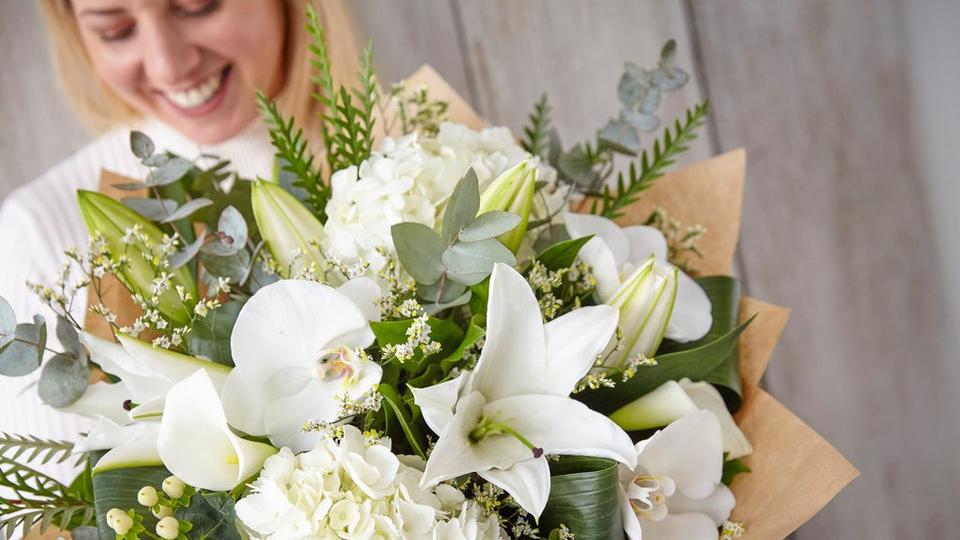Lilies: Ultimate Flower Guide

Known the world over for their distinctive look and fragrance, lilies are one of the most popular cut flowers. Loved by florists, homeowners and brides for the simple elegance they add to bouquets, homes and weddings, you can’t go wrong with lilies. Read on to find out all you need to know about these wonderful flowers.
Lily flower meanings
Lily meanings can vary depending on culture or religion;
- Greece - lilies are associated with rebirth and motherhood.
- China - popular wedding flowers as they are tied to good luck and 100 years of love.
- Assyrians & Babylonians - these cultures associated lilies with Ishtar, the Goddess of fertility.
- Christianity - connects lilies with the Virgin Mary (especially Madonna lilies).
Mythological meaning
In Ancient Greece, Zeus had recently had a son - Hercules. The problem was, his wife Hera was not the mother. Undeterred by this Zeus asked Hera to feed Hercules with her milk and she disagreed. This didn’t stop Zeus, when Hera was sleeping he secretly tried to feed Hercules with her milk. She awoke and pushed the baby away, and the drops of milk that fell to the ground grew into lilies.
Lily symbolism
Lilies are a symbol of grace, purity, majesty and honor. The Victorians used to give lilies to their beloved to show their devotion, and in modern times the lily has evolved to be a symbol of sympathy making them a popular funeral flower.
Lily meanings can change depending on the colour:
- White lilies: Purity and virtue
- Orange lilies: Confidence, pride and wealth
- Red lilies: Passion
- Yellow lilies: Purity, innocence
- Pink lilies: Propperity and abundance
A few facts about lilies
These beautiful flowers are quite interesting too. Here’s a few things you probably didn’t know about Liies:
The lily is the 30th anniversary flower because it’s seen as a flower of devotion.
- Lilies are very toxic to cats and dogs so keep your pets away from them.
- Lily is the most popular flower name for girls.
- Due to their fragrance, lilies are often used in perfumes.
- The Ancient Greeks used lilies to reduce wrinkles.
- Their scientific name is lilium and they belong to the liliaceae family.
- In China lily bulbs are often used in soups, stir frys and cold dishes.
- Brides in Greek and Roman ties were given a crown of lilies in the hope of a pure and fruitful life.
Types of lilies
There are so many lily flower classifications (about 90 species in the lilium genus) that we’ve narrowed it down to some of the most popular garden varieties. Garden lilies fall into nine categories:
Asiatic lilies
Martagon Lilies (known as Turk's Cap Lilies)
Candidum lilies
American Lilies
Longiflorum Lilies
Trumpet and Aurelian Lilies
Oriental Lilies
Interdivisional Lilies
Species lilies
Types of lilies
There are so many lily flower classifications (about 90 species in the lilium genus) that we’ve narrowed it down to some of the most popular garden varieties. Garden lilies fall into nine categories:
Lily care tips
When looked after properly, lilies have one of the longest vase lives of all cut flowers. Here’s how to look after yours:
- Lilies have a vase life of around 10-14 days. Prepare your lilies by diagonally trimming the stems by roughly an inch.
- Remove any leaves that will fall below the water line. This will reduce the build up of bacteria in the water and keep your lily flowers fresher for longer.
- Remove the stamens (the orange / yellow fluffy bits that carry the pollen) to prevent staining. This doesn’t affect the longevity of the flowers. If you get pollen on any fabric, use sticky tape to dap the stain away or gently brush it off. Do not use water as this will make it worse.
- Fill your vase 2/3 full with room temperature water and add the flower food.
- Keep the vase topped up with water daily.
- Change the water and re-trim the stems every few days to maximise vase life.
Note: Hay fever sufferers should opt for unscented varieties as the pollen count is much lower. Oriental lilies are the most heavily scented so avoid these if you have allergies.
Style Tip: Lilies look best in arrangements with taller flowers and they pair beautifully with roses, sunflowers or gladioli.
Warning: Keep lilies away from animals (especially cats and dogs) and children as they can be toxic.
Join Our Newsletter
You’ll get 15% Off Your First Order
Our emails are packed full of beautiful blooms, news and offers. We’ve also got lots of festive gifting ideas too!
We can’t wait to share our love of beautiful blooms with you.
How to arrange lilies
Lilies look best in arrangements with taller flowers and make a bold statement in any room.
They look particularly beautiful when combined with roses or statuesque summer blooms such as sunflowers or gladioli.
If anyone in the family suffers from hay fever an unscented variety may be preferable as they have a lower pollen count whilst the Oriental Lily is the most heavily scented.
Lilies for weddings
The unparalleled beauty of Lilies makes them a popular choice of wedding flowers.
They look fabulous in bridal bouquets and are equally impressive in vase designs and arrangements. That said, be very wary of lily stamens when going down the aisle, particularly if you are getting married in white as they stain easily - ensure your florist removes them first for your own peace of mind.
One of the appealing things about lilies is that they are available all year round and come in a spectrum of different colours meaning that they really can complement any wedding scheme.
How to grow lillies
When to plant lily bulbs
Plant your lily bulbs in late autumn, just before the cold winter weather comes. This gives the roots chance to establish themselves before the ground freezes, and the bulbs benefit from being chilled as theyÂ’ll produce bigger flowers.
Tip: Buy your bulbs just before you plan to plant them for the best results.
How to plant lily bulbs
- Planting lilies is best done in well drained soil in an area that gets lots of sun.
- Most lily flowers prefer acidic to neutral soil, but some varieties (like the Madonna) prefer the soil to be more alkaline so make sure you check.
- Enrich the soil with a bit of fertiliser or well-rotted organic matter.
- Plant the bulbs quite deep - about three times the height of the bulb. Make sure the pointy end of the bulb is facing up.
- Space the bulbs about 8-18 inches apart (depending on the size of the bulb).
- Give them lots of water.
Growing lilies in pots
- Growing in pots is slightly different to growing in your garden. It’s best to plant them in early autumn but you can still plant them through to spring.
- Add some stones to the bottom of your planter to create a drainage layer (about 5 cm or 2 inches). If your planter is raised with holes in the bottom you won’t need to do this. Make sure you have a deep container.
- Plant large bulbs on their own and about three smaller bulbs together. Plant with the pointy end facing up about the depth of the height of the bulb. If the bulb is stem rooting plant it two and a half times the height of the bulb.
- Use a good multi-purpose compost and keep it moist at all times. Feed with tomato feed (or another good high potassium liquid fertiliser) every two weeks during summer.
When do lilies bloom?
Lilies are perennial flowers that bloom from June to August each year. They are available from flower shops all year round.
How to deadhead lilies
Once a lily flower has faded simply break it off with your fingers or snip it off with some shears. This will stop seed pod production and send nutrients to the bulb.
Make sure you don’t remove any leaves until they have gone brown in late autumn. The leaves will continue to nourish your lily bulb for next year which is why it’s important to leave them.


